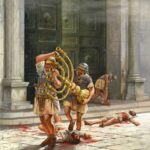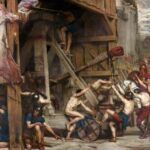Legion X Fretensis was one of the most famous Roman legions. It takes its name from Fretum Sicilium, the channel between Italy and Sicily, known today as the Strait of Messina. The legion created the Octavian Augustus between 41-40 BCE The bull symbol on the Vexillum indicates that it most likely happened between April 17 and May 18, because the bull symbol in the zodiac is dedicated to Venus, the guardian goddess of the Julian family.
An additional symbol of the trireme was also used. Most likely, it commemorates the participation of the X Legion in the sea battle between Octavian and Sextus Pompey, fought in the Strait of Messina in 36 BCE. In the years that followed, as part of Octavian’s army, the legion received two more emblems: the dolphin and the boar. After the aforementioned battle, legionaries from X Fretensis were stationed in Mylae, Sicily, then transferred to Navlochus, Actium and then to Macedonia. Unfortunately, it is not known exactly when the legion ended up in Syria. We know that by 6 BCE Syria was already home to Legio X, Legio III Gallica, Legio VI Ferrata and Legio XII Fulminata. Nearby, in Egypt, Legio III Cyrenaica and Legio XXII Deitoriana were stationed. Among the numerous responsibilities in this troubled area of the Empire, one of the most important was securing the grain supply to Rome.
As is known, in 4 BCE The emperor announced the Empire’s census. At that time, Syria was ruled by Quirinus. Legon X soldiers were sent to Judea to oversee the smooth conduct of the census. At that time, the legion was commanded by the legate Sulpicius Quirinus. The cohorts were stationed at Cyrrhus, on the busy trade route from Antioch to Zengma, one of the most important crossings across the Euphrates. A significant part of the force was located in Jerusalem, and the famous Pontius Pilate commanded them.
In the years 56-58 CE Legio X Fretensis took part in the party’s campaign. He also participated in the siege and capture of the Parthian capital, Artaxata. Soon after, the legion was moved to Cilicia, and in 63 CE back to Syria. In 66 CE Emperor Nero planned an expedition against Ethiopia. For this purpose, Legion X was moved to Alexandria, Egypt. The plans were thwarted by the Jewish rebellion in Judea. Initially, the legionaries established a winter camp at Ptolemais. Later, due to the large number of units mobilized in the area, the legion was moved to Caesarea, a port city in Samaria. The commander-in-chief of the Roman forces was Vespasian, and the commander of Legio X was M. Ulpius Trajanius, the future governor of Syria and the father of Emperor Trajan.
The war with the Jews did not break out suddenly. There have been clashes between the Jews and the Romans since the death of King Agrippa I and the establishment of Roman procurators. The spark that led to the outbreak of the uprising was an attempt to erect a statue of the emperor in the Temple of Jerusalem, committed by the prosecutor Florus.
Despite the fact that the Jews were divided into many opposing factions, they managed to reach an understanding that resulted in the removal of Roman garrisons both from Jerusalem itself and from its vicinity. These initial successes shocked the entire Empire. The emperor was aware that the rebellion of this small nation must be suppressed very quickly, otherwise, other provinces would change their minds about the true strength of Rome.
Endowed by the Emperor with the best armies and virtually unlimited power, Vespasian sailed to Judea. For the campaign aimed at taking Jerusalem, he raised an army of 60,000 people in total. Confident of his strength, Vespasian entered 67 CE to Galilee. Legion X Fretensis was used to capture the fortified cities of Tarichacae and Gamala, located on the eastern and western shores of Lake Gennesaret (Galilee). Vespasian then deposited the legion in Scythopolis, on the west bank of the Jordan River. In the same year, other legions captured Jotapata, where the famous historian Józef Flavius, author of the “Jewish War”, commanded the defence. The city was taken on July 20, 40,000 Jews died, and the buildings were razed to the ground.
After these victories, Vespasian and his two legions, Legio X and Legio V, hastily returned to Caesarea for wintering. The suppression of the uprising in Judea was successful. Only Jerusalem and Masada, the desert stronghold of the zealots, remained outside the control of the Romans. At the same time, however, Emperor Nero lost his power and life in Rome. The empire was shaken by civil war. Following the Gallic rebellion of Vindex and the brief reign of Emperors Galba, Otho, and Vitellius, the legions in the east proclaimed Vespasian as emperor. He returned to Rome and secured his rule within a year. However, he did not forget about the Jewish mutiny, sending his son Titus to settle the matter once and for all. The most important thing was the campaign against Jerusalem. In the hills around the city, Titus deployed four legions. Legio V is in the North. Legio X was on the Mount of Olives, and Titus himself chose Mount Scopus as his headquarters, where the XII and XV Legions were stationed. However, Titus did not fully trust the strength of the XII Legion after the defeat of Cestius Gallus at Beth-Horon in Galilee due to the stupidity of Cestius and therefore sent him finally north to Melitena.
During the siege of Jerusalem, Legio X Fretensis became famous for the effective use of various types of machines. It was noted that they were able to throw stones weighing about 25 kg at a distance of over 400 meters. The ballista shells did a lot of damage, especially after the idea of dyeing the stones black so that defenders would notice them as late as possible. Flavius Josephus mentions that he saw a bullet tear off the head of a defender standing on the walls and throw it back three furlongs – over 500 meters! (But you must also remember that Joseph had a certain tendency to exaggerate.) The siege of Jerusalem lasted five months, and its inhabitants experienced all the horrors – especially hunger. Finally, after combined attacks, the legions captured the Holy City in September 70 CE. Titus marched to Masada. In devastated Jerusalem, he left Legio X Fretensis as an occupation garrison.
In the spring of the following year, Titus sent the V and Fifth Legions back to their home provinces and sailed to Rome. From there, a new commander, Lucillus Bassus, was sent to carry out various “clean-up operations” in Judea – with the help of the legionaries of Fretensis, of course. There were a few single points of resistance outside Masada. Legio X captured Herodion and crossed the Jordan to capture Macheront on the eastern shore of the Dead Sea. Bassius was unable to complete the work, being sick. Flavius Silva was his replacement.
In the fall of 72 CE, Silva left for the last Jewish stronghold, Masada. He led Legio X, auxiliary troops and thousands of prisoners. When the demands for surrender were rejected, Silva encamped the fortress, situated on a seemingly inaccessible high mountain. The last point of the resistance of the Jews was not subjected to any of the heavy, also mentally exhausting attacks. The defenders swore: “We will have no master but God.” When the Romans, after building the ramp visible to this day, finally stormed the walls of Masada, they were greeted by a dead silence. The defenders chose suicide, depriving the conquerors of the joy of the victory.
After the suppression of the rebellion, the Legio X Fretensis became the garrison of Jerusalem. The main camp was on a hill in the southern part of the Old Town, now towering over all the buildings. At that time, it was the only order-keeping legion in the pacified province. Legio X also took part in Trajan’s great campaign against the Parthians, which greatly enlarged the territory of the Empire. In 130 CE Emperor Hadrian undertook his imperial journey to Judea, Arabia and Egypt. To prepare it, the Romans began a series of costly investments in the repair of Judean roads and began rebuilding Jerusalem. Legion soldiers were also used for the work. Misto was renamed Aelia Capitolina, in honour of the Emperor (his first name was Aelius) and Capitoline Jupiter – the Emperor’s favourite god. The change of the name of the city was also supposed to depress the Jews who still lived there. Two years later, the Judeans again disobeyed the tough rule of Rome. This revolt, known as the Bar Kochba Uprising, involved a large chunk of Roman forces in the region. After initial failures, the Romans managed to control the revolt and drown it in blood three years later.
Legio X was stationed in Aelia Capitolina as a permanent unit of the Roman province of Judea. The north of the country was guarded by Legio VI. Sources record the presence of Fretensis in Judea in 150 CE and in 215 CE when the region was called Syria Palestina. Still, in 300 CE Legio X was in Palestine, then transferred to Aila – today’s Eliat on the Red Sea, where it guarded an important communication route. During this time, the legion changed significantly in character and structure. Barbarians became more and more soldiers and soon led to the Empire’s burial.







